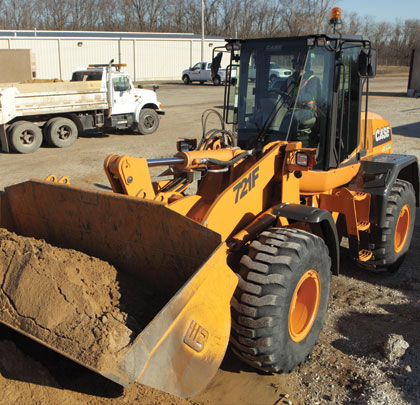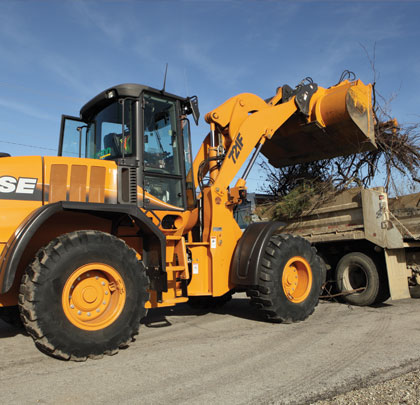The Village of Winfield, Illinois, looks to its Public Works Department (PWD) to run lean while also delivering a high level of service to residents. Superintendent Tye Loomis and his crew are responsible for snow removal and maintenance of 36 miles of roads and 42 miles of water and sewer pipeline, as well as dealing with storm damage and general infrastructure management in this Chicago suburb of more than 9,000 people. According to Loomis, flexibility and versatility are critical, given the need to respond to virtually any number of challenges brought on by man or Mother Nature.
“Our list is a mile long with new requests every day, which is in addition to our normal workload,” Loomis says. “There’s no question our team does a great job, but we’re a staff of eight. That puts a premium on maximum productivity from every person and every piece of equipment.”
THE NEXT LEVEL
Loomis knew the performance and reliability of his existing wheel loader was not up to the task. He had some ideas about a new loader, but turned to Steve Costello at McCann Industries for advice. McCann and Loomis reviewed the choices for a larger, more technically advanced unit.
“Obviously, we use the wheel loader to move a lot of material, but that’s an over-simplification,” Loomis says. “When stockpiling salt and gravel, for example, we have a very small footprint to work within at the yard. As such, we needed a more powerful loader that can constantly push the piles up and keep them contained. Our former loader seemed to struggle with it even though it wasn’t an old unit, which slowed things down.”
“At the end of the day, we needed a wheel loader that could do more than what we were able to do before,” he says. “We wanted a machine that would add value—all the while helping us keep within the confines of a limited budget. As an environmentally friendly municipality, we also felt it was important to purchase a loader that helped us meet emission standards.”
After consulting with Costello at McCann Industries, the Village of Winfield replaced its former wheel loader with a Case 721F wheel loader.
The 721F wheel loader is powered by a Tier 4 Interim 6.7 liter Case/FPT diesel engine, which delivers 179 hp, and uses Selective Catalytic Reduction (SCR), an advanced cooling technology, to save fuel and reduce emissions without sacrificing power. The wheel loader also features a 3.25-yd3 (2.5 m3)-capacity bucket and is equipped with a number of attachments.
STOCKPILING GOES SMOOTHLY
The 721F makes stockpiling easier with the help of the four-speed transmission that provides superior torque and performance. The bucket profile of the wheel loader also affords increased penetration into the wall face for faster fill and shorter cycle times.
“The 721F has more than enough power for stockpiling,” says Loomis.
The 721F wheel loader’s powerful engine and transmission also contribute to improved productivity in the field, including tasks associated with water main breaks.
“We use the wheel loader to backfill the dig with dry topsoil or gravel on water main breaks,” Loomis explains. “We also use it to remove and stockpile the wet and extremely heavy spoils from the dig. The 721F does a great job despite the sheer weight of the material.”

SHORT WORK OF DIVERSE PROJECTS
The Winfield PWD crew appreciates the versatility of the wheel loader, thanks to a number of different attachments and the ease of changing them. For example, in the past, Winfield PWD crews would pick up brush by hand and load it into a tub grinder for chipping on-site. According to Loomis, that changed for the better.
“We can now use a bucket-grapple configuration with the 721F wheel loader that allows us to easily pick up and load the brush into trucks for disposal back at the yard,” he says. “We’ve gained time and manpower efficiencies, plus our operators can get the job done without damaging the ground of the parkway because the unit gives our operators an incredible level of control.”
Loomis discovered the value of the grapple attachment in a big way during a massive summer storm that knocked down hundreds of trees. The crew had a tub grinder brought to the site and used the 721F to pick up the brush and feed it into the grinder in an effort to clear the debris as quickly as possible.
“The new wheel loader allowed us to cut the time of the project in half. Plus, we saved money because we used our own wheel loader for the job rather than using the one supplied by the company that brought in the grinder,” Loomis explains.
KEPT TO A MINIMUM
Whether working in the field or in the yard, the 721F wheel loader helps the village meet its emission standards for heavy equipment while conserving the PWD’s fuel budget.
The unit’s SCR technology, an after-treatment system, cuts emission levels with no limitation to engine output. The technology is used extensively on trucks in Europe and is a well-proven and reliable solution that meets the EPA’s Tier 4 Interim emission standards.
“We’re pleasantly surprised with the fuel economy of the machine,” Loomis says. “Given the extra power we get out of the unit, we would have expected to use a lot more diesel but we don’t. We also appreciate the fact that it limits emissions, especially since the machine idles for hours at a time during the winter months.” ■
About The Author:
Brad Stemper is a solutions marketing manager with CASE Construction Equipment. For more information on the CASE equipment, visit www.casecs.com.
_________________________________________________________________________
Modern Contractor Solutions, September 2013
Did you enjoy this article?
Subscribe to the FREE Digital Edition of Modern Contractor Solutions magazine.

Stretching the Budget


